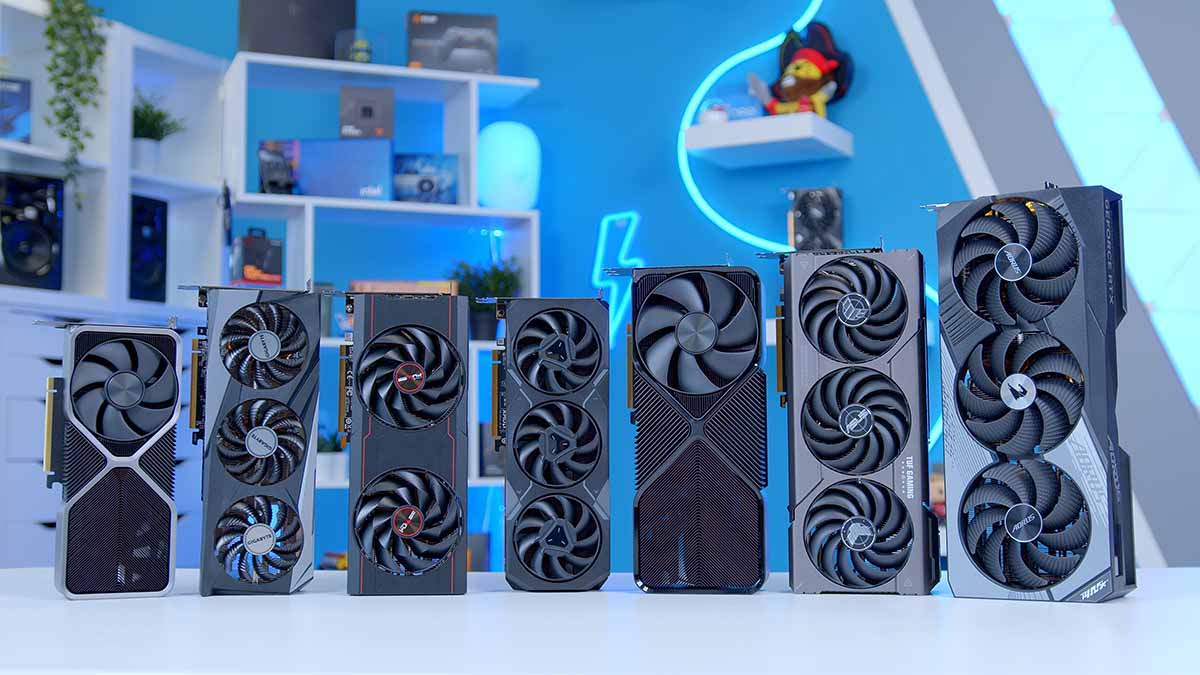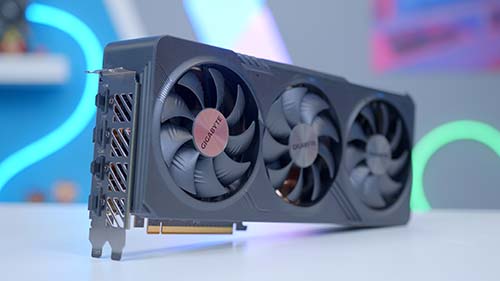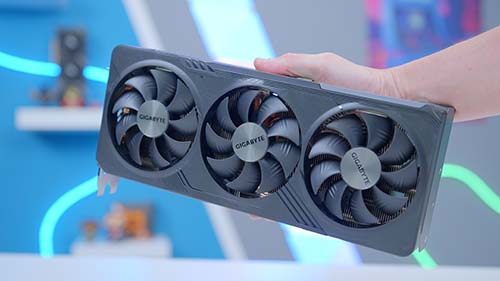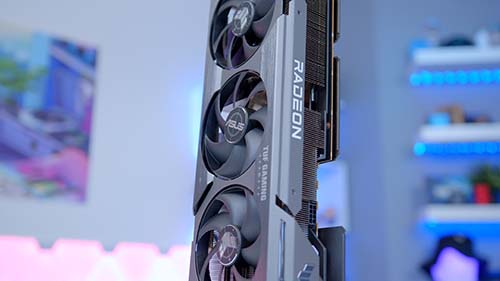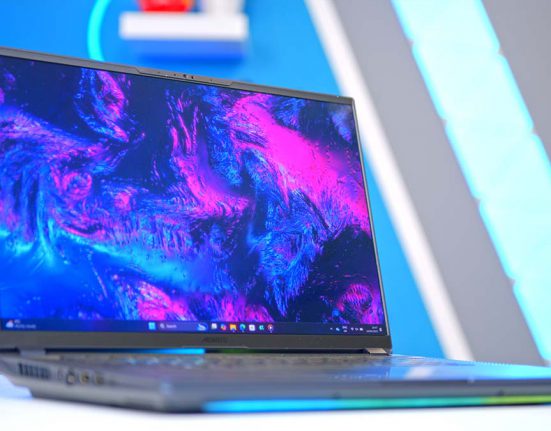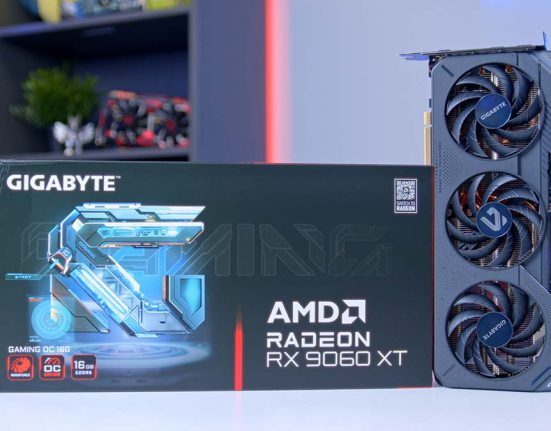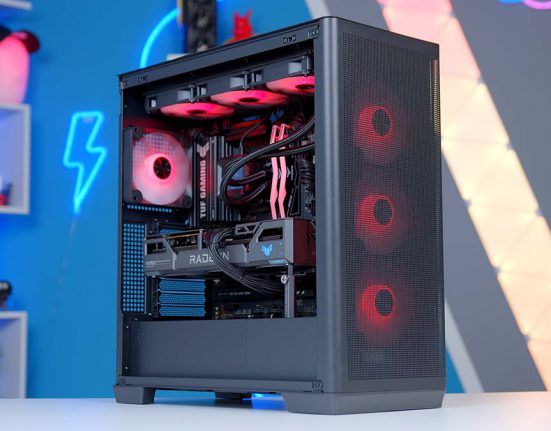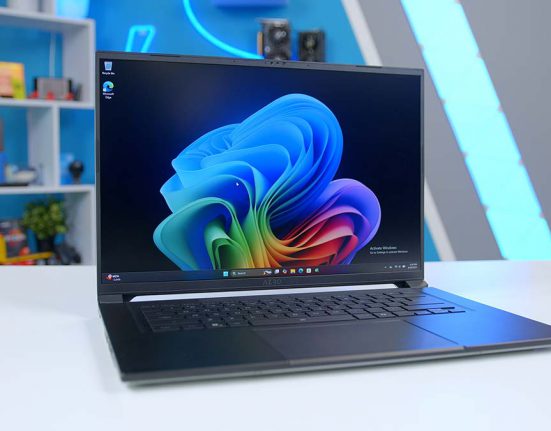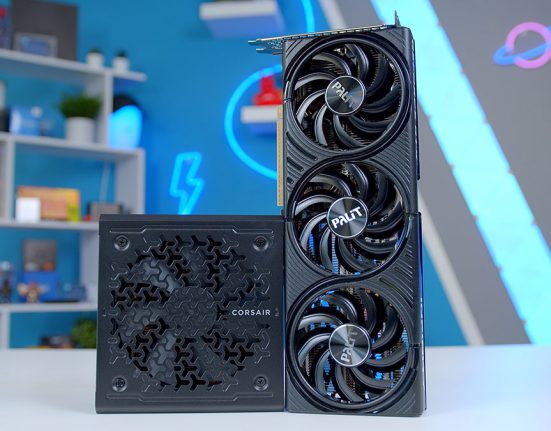The graphics card market in 2025 is incredibly competitive. NVIDIA, AMD, and Intel are constantly battling to beat one another in pricing and performance by offering new GPUs or slashing existing prices down to a more affordable level. With so many new cards hitting the shelves, purchasing the right option for your PC build can be confusing. So, how do you determine which graphics cards are the best to buy out of the myriad of GPUs available?
Here at GeekaWhat, we’re well-equipped to recommend the best options for a range of budgets, which is precisely what we’ll be doing here. Harry Coleman and James Cousins from our team are experts in GPU benchmarking and testing, having benchmarked every card released by AMD, NVIDIA, and Intel in the last few years.
Our testing includes some of the biggest games out there, from popular esports titles like Apex Legends and Fortnite to demanding AAA titles like Cyberpunk 2077, Starfield and Alan Wake II, which gives us 1000s of data points for comparison. You can learn more about how we test graphics cards and view detailed gaming benchmarks for all of the cards below.
Best Graphics Cards Under $250
1. Intel Arc B570
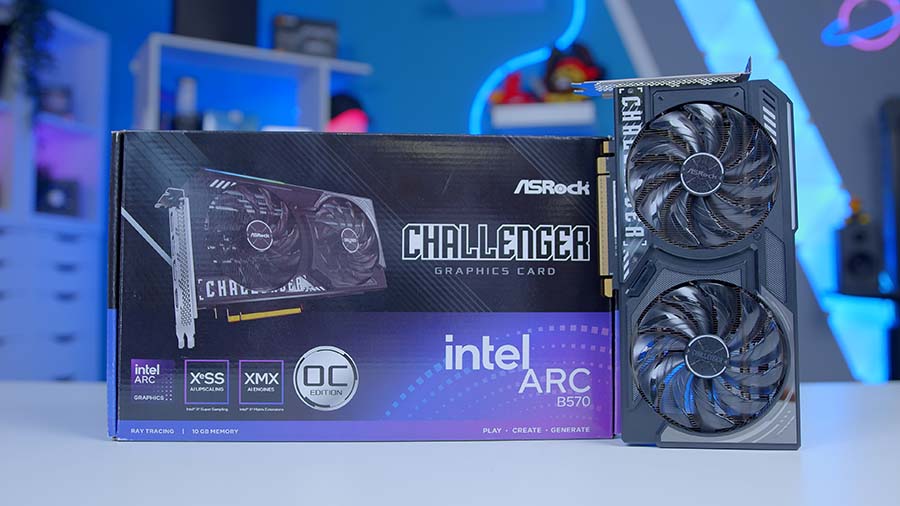
The first graphics card in this roundup is Intel’s ARC B570. This GPU is part of the second generation of ARC cards, which were received with far less criticism than the first-generation cards. The reasons why we’ve put this card in first place are twofold. The first is its price. GPUs have continued to increase in price over the years, and the ARC B570 is one of the cheapest graphics cards on the market, with an MSRP of $220, beating out the AMD Radeon RX 7600 and NVIDIA RTX 4060.
The second reason is its performance. The ARC B570 has received a massive performance boost compared to its predecessors. Gone are the driver problems we saw on ARC A-series cards. The ARC B570 is primarily a 1080p graphics card, but our testing offered solid metrics across 1440p, including over 60FPS in Cyberpunk 2077 and similar performance in Hogwarts Legacy. This GPU impressed us during its initial launch and is worth considering if you’re sticking to a budget below the $250 mark.
| Key Specs | Intel Arc B570 |
|---|---|
| Video Memory Capacity | 10GB GDDR6 |
| Memory Bus | 160-Bit |
| Base Clock Speed | 2.5GHz |
| Boost Clock Speed | 2.5GHz |
| Xe Vector Engines | 144 |
| Xe Cores | 18 |
| Power Draw | 150W |
| MSRP | $219.99 |
Regarding its specs, the ARC B570 features 10GB of GDDR6 VRAM, sitting on a 160-bit memory bus. While a larger memory bus would be ideal, it’s great to see more than 8GB of VRAM on a budget graphics card aimed at 1080p. This card has a TDP of 150W, which means installing a 500W power supply is more than feasible. The ARC B570 is a reasonably small graphics card, so you won’t have any issues installing this GPU inside a small form factor build.
In terms of caveats, Intel’s drivers are still fresh on the scene, and therefore, the ARC B570 struggles in certain older games and newer titles. While the drivers have seen considerable improvement, stability is not one of their key strengths, especially when compared to NVIDIA and AMD. For this reason, if you’re looking for a more stable driver experience with your graphics card, we recommend picking up one of the competitor options.
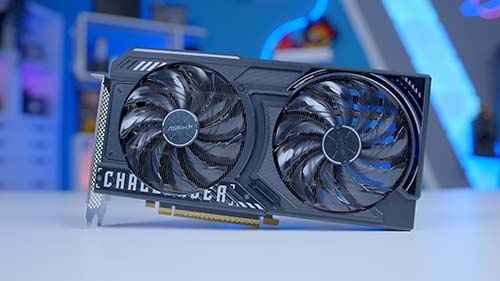
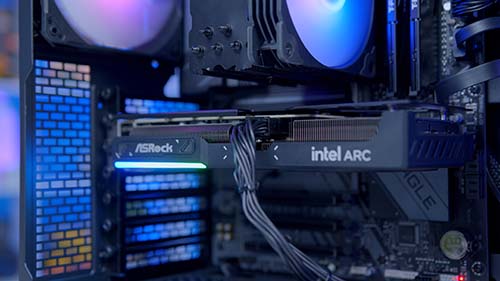

Best Graphics Cards Under $300
2. NVIDIA GeForce RTX 4060
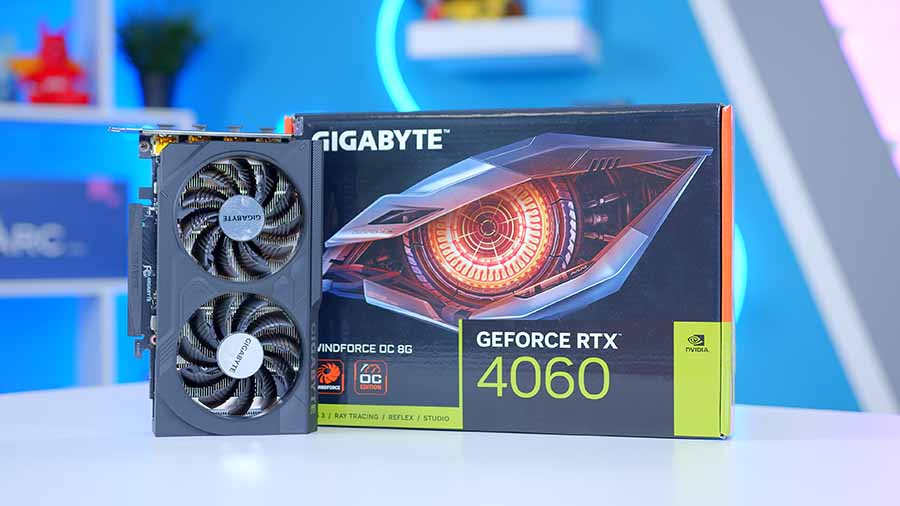
Up next is the RTX 4060 from NVIDIA. During its initial launch, the RTX 4060 received plenty of criticism due to its weak memory bus and 8GB VRAM capacity, alongside the reasonably high MSRP of $299.99. But despite this, the RTX 4060 (according to the Steam Hardware Survey) is one of the most popular graphics cards among gamers. The 60-series of GPUs has always been the best option for budget gamers, but the RTX 4060 is definitely one of the more competitive choices.
With 8GB of VRAM on a 128-bit memory bus, the RTX 4060 is primarily aimed at 1080p gaming. However, across our benchmarks, we’ve seen it compete with the ARC B580 at 1440p, offering more than playable framerates in a range of titles. VRAM is not the be-all and end-all for graphics cards, with the RTX 4060 demonstrating its resilience at 1080p and 1440p.
| Key Specs | NVIDIA GeForce RTX 4060 |
|---|---|
| Video Memory Capacity | 8GB GDDR6 |
| Memory Bus | 128-Bit |
| Base Clock Speed | 1.83GHz |
| Boost Clock Speed | 2.46GHz |
| Stream Processors | 3072 |
| Ray Accelerators | 24 |
| Power Draw | 115W |
| MSRP | $299.99 |
Additionally, gamers can leverage the performance benefits of picking up an NVIDIA graphics card, such as DLSS and Frame Generation. These pillar technologies allow you to significantly increase framerates across the board, making it worthwhile to switch them on in supported titles for better visuals and generally smoother gameplay.
The main limitation of this graphics card compared to other GPUs is its VRAM. While 8GB is sufficient in most instances, the RTX 4060 will struggle in newer titles as they become increasingly more intense, especially at 1440p, where having access to more VRAM is beneficial.
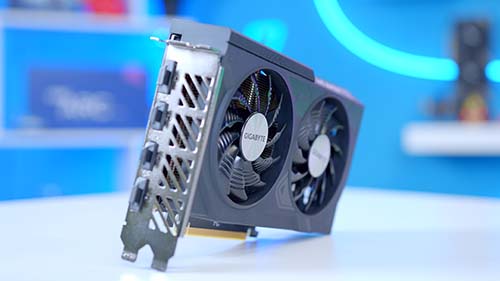
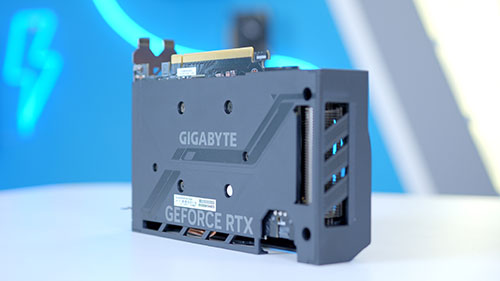
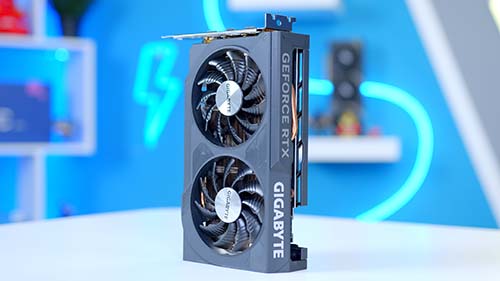
Best Graphics Cards Under $400
3. AMD Radeon RX 7700 XT
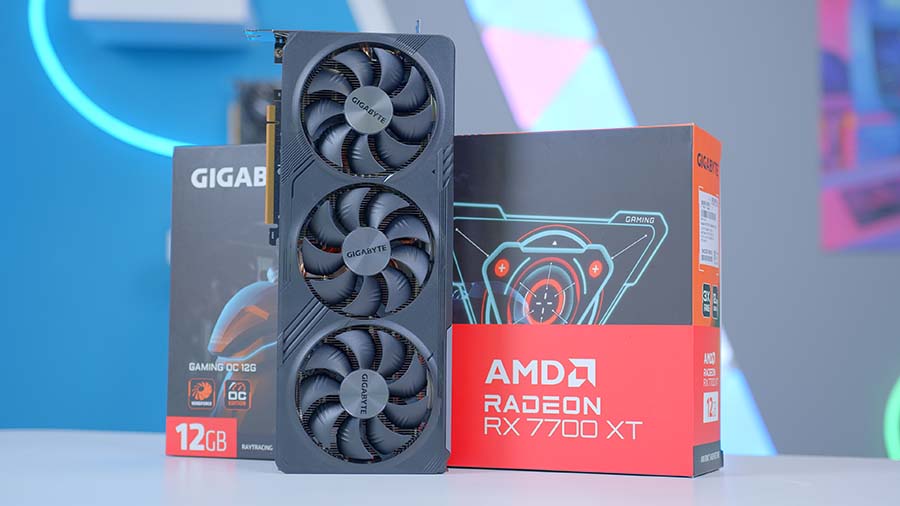
The RX 7700 XT is geared towards buyers with more cash to spend and looking to play most of their games predominantly at 1440p. Due to a range of price drops, the RX 7700 XT offers a better value proposition than it did during its initial launch, now sitting around the $400 mark. This puts about $100 of room between the RX 7700 XT and the RX 7800 XT, making the former a solid option for those sticking to a tight budget.
Performance-wise, the RX 7700 XT is a massive competitor in the 1440p space, with high framerates in most titles. In modern AAA games like Hogwarts Legacy, the RX 7700 XT can easily cope with the performance requirements, outputting an average framerate of 92FPS in our testing. This GPU’s rasterisation capability is phenomenal across Esports titles, too, offering up to 209FPS in Apex Legends at 1440p and 295FPS in Fortnite at 1080p. Overall, the RX 7700 XT is a terrific bang for your buck option.
| Key Specs | AMD Radeon RX 7700 XT |
|---|---|
| Video Memory Capacity | 12GB GDDR6 |
| Memory Bus | 192-Bit |
| Base Clock Speed | 1.7GHz |
| Boost Clock Speed | 2.54GHz |
| Stream Processors | 3456 |
| Ray Accelerators | 54 |
| Power Draw | 245W |
| MSRP | $449 |
The only major weakness worth considering is this GPU’s ray-tracing capability. While AMD cards have come a long way with improvements to ray-traced gameplay and performance uplifts with their FSR technology, NVIDIA’s cards are plainly better regarding ray-tracing. AMD thrives in rasterised games, but buyers looking to play their favourite titles with ray-tracing switched on should look at some NVIDIA options.
Furthermore, we recommend keeping an eye out for the Radeon RX 9070 and 9070 XT models. Set to launch sometime in March, these cards are part of the Radeon 9000 lineup and compete with the NVIDIA RTX 5070 and 5070 Ti models. If you’re looking for an upgrade, these might be worth picking up in the future.
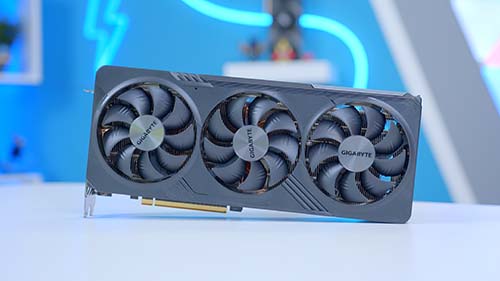
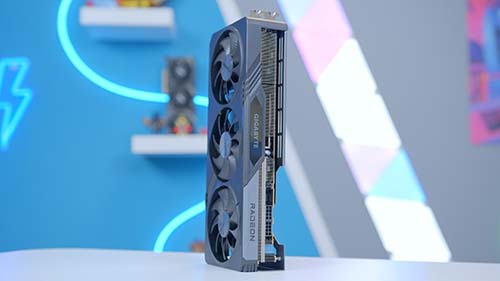
Best Graphics Cards Under $500
4. AMD Radeon RX 7800 XT
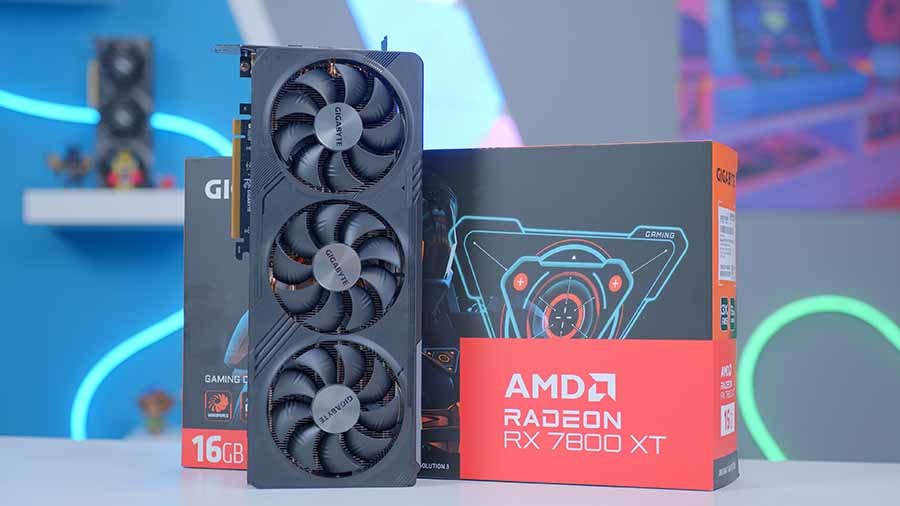
AMD’s RX 7800 XT is one of the most impressive mid-range graphics cards released by Team Red. It is an incredibly strong 1440p capable graphics card that maximises framerates across many games.
The RX 7800 XT’s rasterised capability is unrivalled at this price class, making it a very cost-effective option for 1440p gaming. For example, in Hogwarts Legacy, the RX 7800 XT offered an average frame rate of 102FPS. This is one of the few graphics cards that provides strong framerates across AAA titles while maintaining a very affordable price tag.
One of the significant benefits of this card versus the RTX 4070, in particular, is the 16GB of GDDR6 VRAM you have available to you. While the 4GB bonus versus the RTX 4070 won’t be noticeable immediately, there are more performance benefits in demanding AAA titles where VRAM usage is much higher, especially at 1440p. It is also good for the overall longevity of the card moving forward.
| Key Specs | AMD Radeon RX 7800 XT |
|---|---|
| Video Memory Capacity | 16GB GDDR6 |
| Memory Bus | 256-Bit |
| Base Clock Speed | 1.29GHz |
| Boost Clock Speed | 2.43GHz |
| Stream Processors | 3840 |
| Ray Accelerators | 60 |
| Power Draw | 263W |
| MSRP | $499 |
Unlike the RTX 4070, the RX 7800 XT isn’t a great graphics card for ray tracing. AMD hasn’t entirely caught up to NVIDIA regarding their ray tracing technology, resulting in generally weaker performance when ray tracing is switched on. We recommend looking at some NVIDIA alternatives if you plan to push your gaming PC with ray traced games.

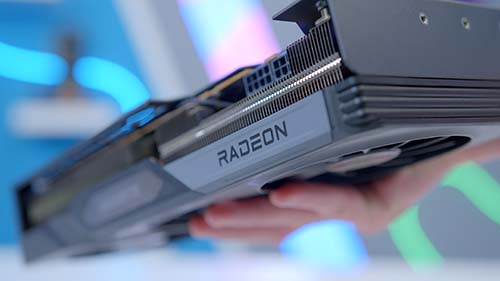
Best Graphics Cards Under $800
5. AMD Radeon RX 7900 XT
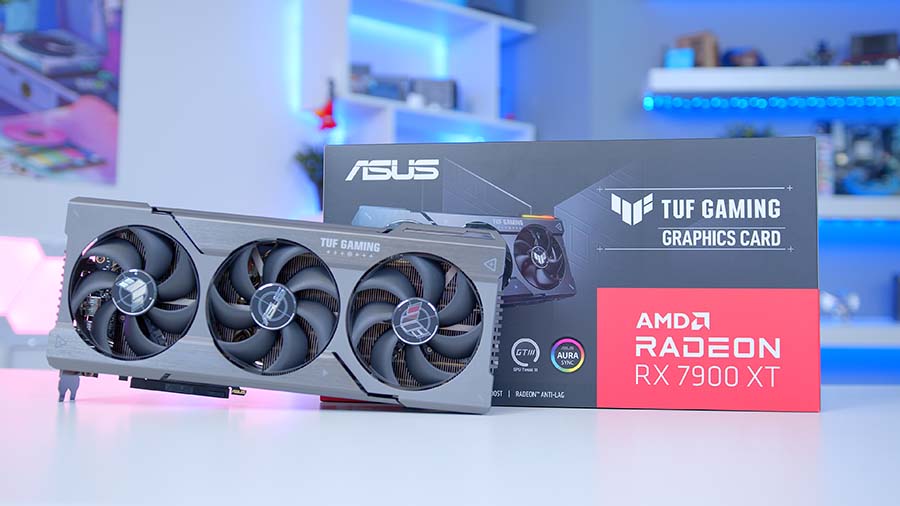
One of the best graphics cards under the $800 mark is the AMD Radeon RX 7900 XT. Initially, we felt that the RX 7900 XT was an excellent card launched with a price class that didn’t match the performance output. However, AMD responded to this during NVIDIA’s RTX 4000 SUPER launch by slashing the price to $700, which is a much more reasonable amount of money to spend on this particular card.
Performance-wise, the RX 7900 XT is a powerful graphics card offering 115FPS in Hogwarts Legacy, with increasingly solid performance across other AAA titles. Games like Apex Legends and COD Warzone also pose no problems for the RX 7900 XT at 4K and 1440p, making it a great contender at this price point.
| Key Specs | AMD Radeon RX 7900 XT |
|---|---|
| Video Memory Capacity | 20GB GDDR6 |
| Memory Bus | 320-Bit |
| Base Clock Speed | 1.5GHz |
| Boost Clock Speed | 2.39GHz |
| Stream Processors | 5376 |
| Ray Accelerators | 84 |
| Power Draw | 300W |
| MSRP | $899 |
Like its siblings, the RX 7900 XT struggles with ray tracing. AMD’s high-end GPUs cannot compete with NVIDIA when it comes to ray-traced gameplay. However, if you’re willing to sacrifice this feature, the RX 7900 XT is one of the most competitively priced GPUs on the market and worth considering for a high-end PC build.
An alternative we recommend if you’re willing to maximise your spending in this price bracket is the NVIDIA RTX 5070 Ti. While this card hasn’t had the most fantastic reception, it is arguably better than the RTX 4070 Ti SUPER. We’d typically recommend the RTX 4070 Ti SUPER in this instance, but with stocks depleting, we imagine this card will be much harder to pick up in the future.
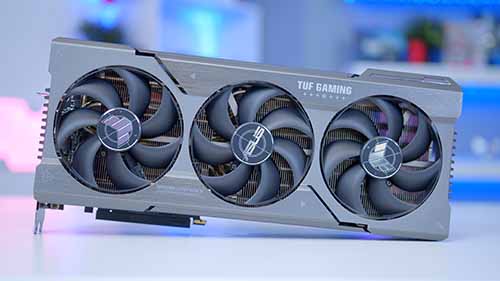
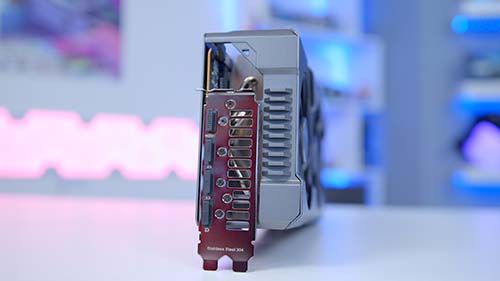
Best Top-End Graphics Cards
6. NVIDIA GeForce RTX 5080
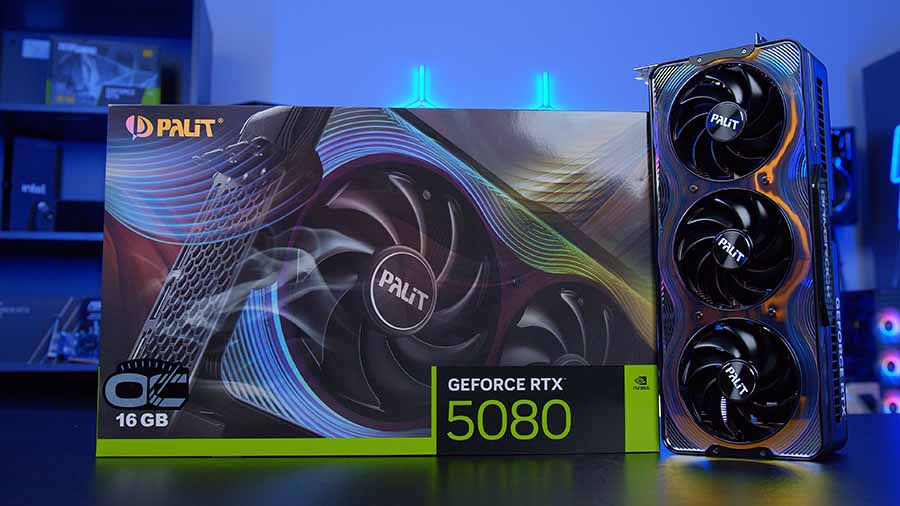
The NVIDIA RTX 5080 is the second card in the 50-series lineup. This behemoth of a graphics card is aimed at 4K gaming and is an ideal pickup for those building a powerful top-end PC. Across our testing, we saw a 15-30% uplift in performance compared to the previous generation’s RTX 4080 SUPER, providing solid framerates within a range of AAA titles at high settings.
The most notable improvement to NVIDIA graphics cards with RTX 5000 range is the upgrades to DLSS, and Frame Gen. NVIDIA continues to train its AI models, further minimising performance overhead and increasing framerates where possible. Multi Frame Gen (introduced with the arrival of 50-series cards) also makes your favourite games perceivably smoother, minimising artifacts and stutters in supported titles.
| Key Specs | NVIDIA GeForce RTX 5080 |
|---|---|
| Video Memory Capacity | 16GB GDDR7 |
| Memory Bus | 256-Bit |
| Base Clock Speed | 2.29GHz |
| Boost Clock Speed | 2.61GHz |
| CUDA Cores | 10752 |
| RT Cores | 84 |
| Power Draw | 360W |
| MSRP | $999 |
Regarding the specs, the RTX 5080, on paper, is pretty similar to its RTX 4000 counterpart, with 16GB of VRAM on a 256-bit memory bus. Cores and clock speeds have increased slightly, but not by a considerable margin, with MSRP also staying the same at $999. Overall, the RTX 5080 is an excellent graphics card and is the superior choice compared to the RTX 4080 SUPER.
However, this card is not without its caveats, the most notable of which are stocking and pricing. While the RTX 5080’s MSRP is $999, it’s unlikely that you’ll be able to pick up a GPU at this price point. Since the RTX 5080 hit the shelves, pretty much all of the MSRP variants have been out of stock, with AIB card prices skyrocketing. If you’re looking to pick up an RTX 5080, you may spend more than $999.
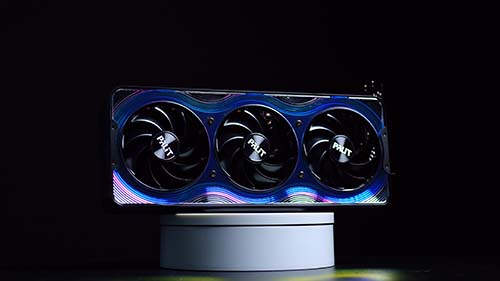
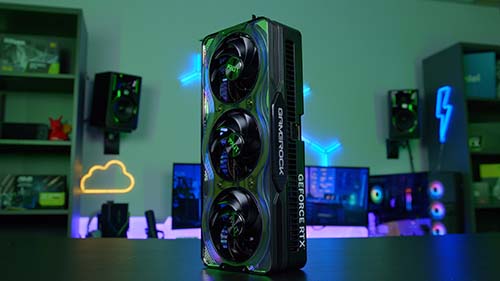
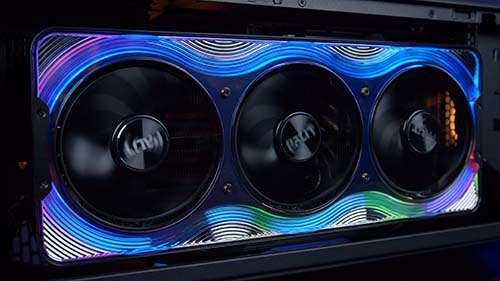
7. NVIDIA GeForce RTX 5090
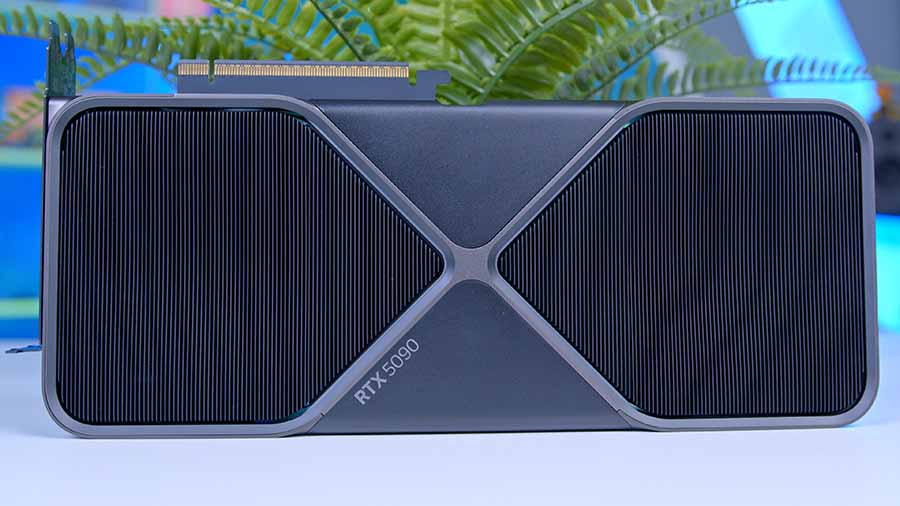
NVIDIA again proves its dominance in the high-end graphics card space with the RTX 5090. This was the most anticipated RTX 5000 GPU before its arrival in January 2025, and needless to say, it does not disappoint. It has 32GB of GDDR7 VRAM on a 512-bit memory bus, all the cores you’ll ever need, insane clock speeds, and solid cooling support.
The RTX 5090 is a powerhouse in 4K and an incredibly viable option for those looking to max out settings in their favourite titles. This can be pushed even further with settings like DLSS and Frame Gen, where performance can go even further when switched on. NVIDIA’s constant improvements to AI-accelerated upscaling mean that DLSS is relatively caveat-free and worth switching on where available.
| Key Specs | NVIDIA GeForce RTX 5090 |
|---|---|
| Video Memory Capacity | 32GB GDDR7 |
| Memory Bus | 512-Bit |
| Base Clock Speed | 2.01GHz |
| Boost Clock Speed | 2.40GHz |
| CUDA Cores | 21670 |
| RT Cores | 170 |
| Power Draw | 575W |
| MSRP | $1999.99 |
Overall, the RTX 5090 is a reasonably unique graphics card. Its 32GB of GDDR7 VRAM allows it to compete in challenging and more burdensome workloads, making it great for a hybrid workstation system.
It’s no surprise that a powerful graphics card like the RTX 5090 comes with a rather high associated cost. At just under $2000, the RTX 5090 is very expensive, geared towards enthusiasts and those building a top-end PC. Needless to say, if you want this graphics card, you’ll need to have plenty of extra cash to spare.

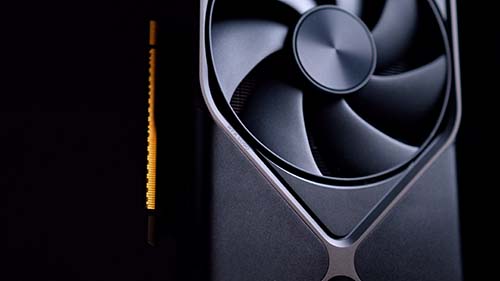
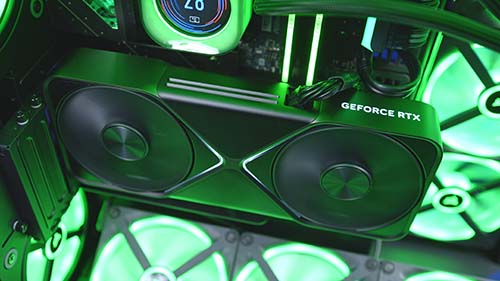
How We Tested the Best Graphics Cards
All graphics cards in this article have undergone rigorous testing to provide us with heaps of data. We then use this performance data to inform our recommendations, ensuring each component option caters to many buyers.
All the graphics cards we test are benchmarked within a plethora of Esports games and AAA titles at three major resolutions (1080p, 1440p, and 4K). We also record all our settings to ensure our tests are fair and repeatable. You can find a full rundown of our testing and benchmarking methodology in our article on How We Test Graphics Cards.
Gaming Performance
One of the most important metrics to assess a graphics card is to see how it performs within your favourite games. We’ve accumulated a mass of data from AMD, NVIDIA, and Intel GPUs. In this section, we’ll run you through the performance to see how these cards perform across Esports and AAA games.
Hogwarts Legacy
Settings: 1440p, Shadow Quality High, Indirect Lighting High, Reflections High, Crowd Density High, Particle Quality High, Volumetric Lighting High, Motion Blur off, GTAO Quality High, Grass Quality High, Contact Shadows High VSync Off, DLSS/FSR: Off, Ray Tracing: Off, Textures: High
In Hogwarts Legacy at 1440p high settings, we saw pretty solid performance from the ARC B570 and RTX 4060, with 61FPS and 62FPS averages, respectively. It’s impressive to see both of these cards hold up well at 1440p despite being geared more towards 1080p. The RX 7700 XT offers a reasonable performance uplift, with a 92FPS average, followed by the RX 7800 XT with 102FPS. The increased VRAM here definitely benefits the mid-range cards in this game.
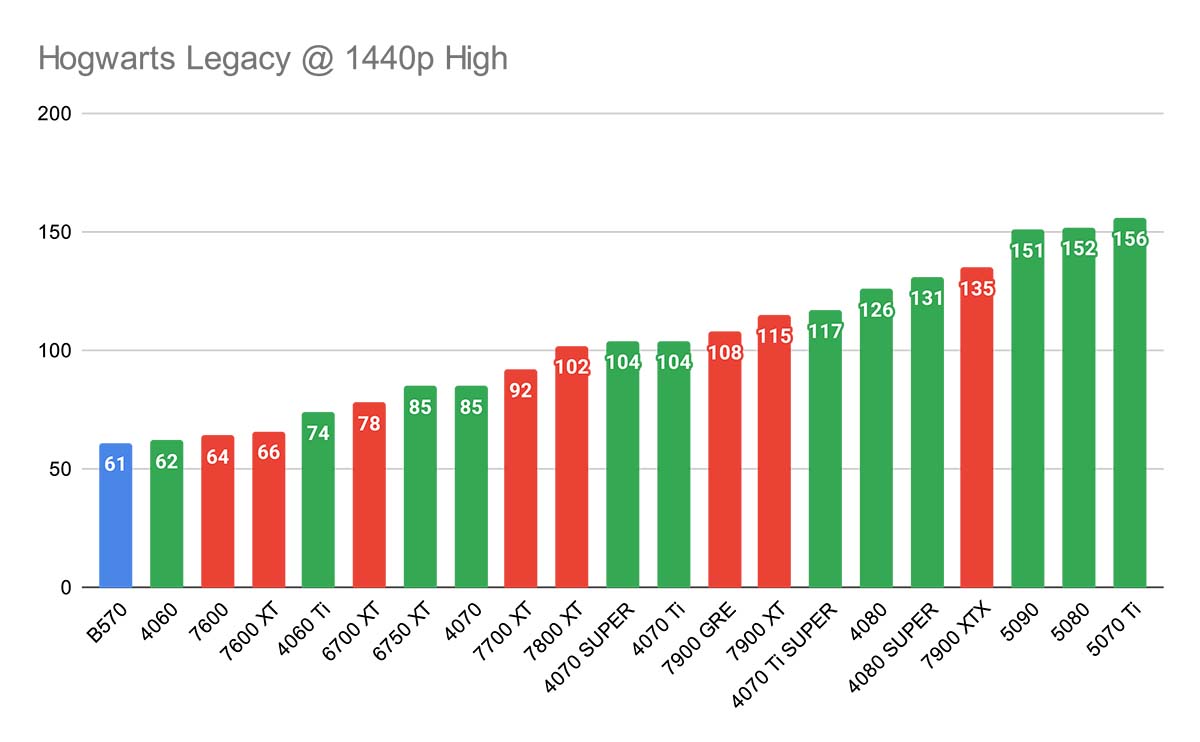
The RX 7900 XT outputs 115FPS on average, with the RTX 4080 SUPER offering around 16 more frames up to 131FPS. Ultimately, hitting high frame rates isn’t as crucial in this single-player title. Still, those looking for more stability will want to pick up a mid-range or high-end graphics card to ensure performance doesn’t dip in intense areas of the gameplay.
It’s no surprise that the RTX 5000-series cards come out on top here, with the RTX 5070 Ti leading the way. All three of the RTX 5000 cards we’ve tested sat over 150FPS, which is an impressive metric, considering this is purely rasterised performance with no additional enhancements like DLSS or FSR.
Apex Legends
Settings: 1440p, Anti-aliasing TSAA, Texture Filtering 8X, Model Detail High, VSync Disabled, Effects High, Ambient Occlusion Quality High
In Apex Legends at 1440p, performance was consistent across all graphics cards we tested. The RTX 4060 and ARC B570 sit at the bottom of the graph with 137FPS and 144FPS, respectively. However, it’s still great to see that the ARC B570 can surpass the 144Hz sweet spot, making it great for some budget-competitive gaming.
Moving up the graph, the RX 7700 XT and RX 7800 XT have a fairly noticeable gap between them, with the RX 7700 XT offering 175FPS and the RX 7800 XT sitting at 232FPS. The gap won’t be particularly discernible at framerates this high, but the RX 7800 XT is the clear choice if you’ve got a monitor that offers a very high refresh rate.
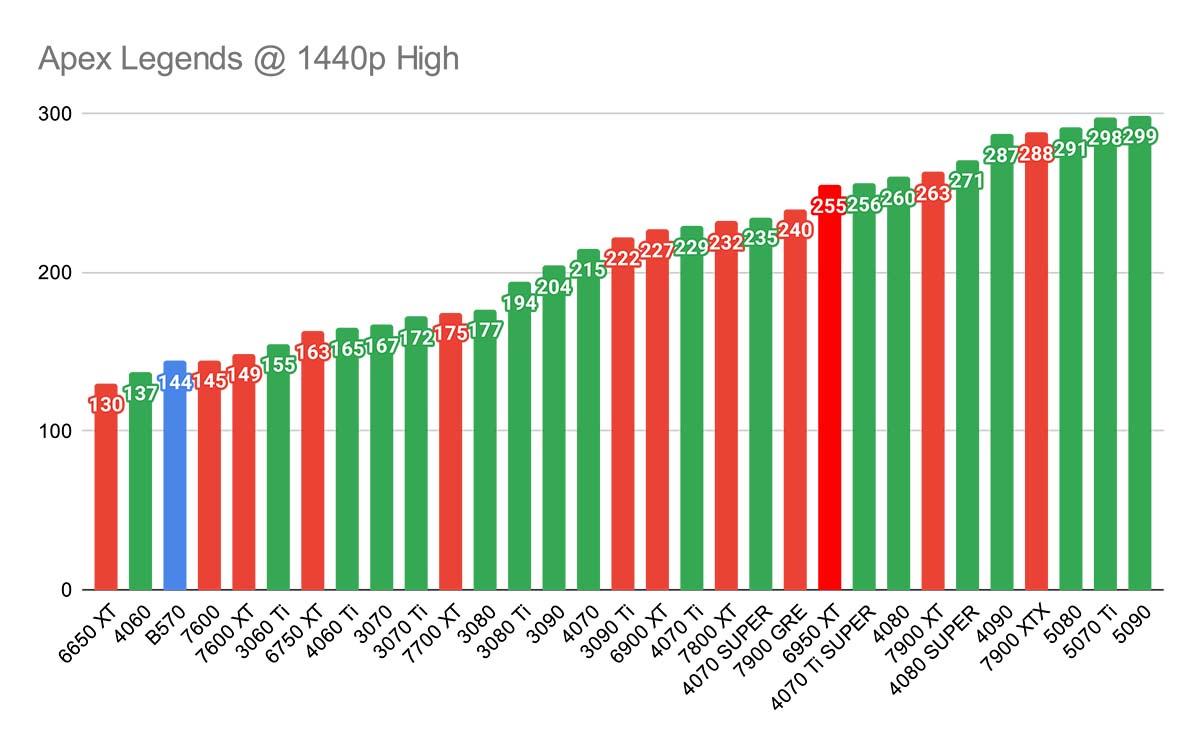
The top-end graphics cards in this benchmark continue to showcase exceptional performance, with the RX 7900 XT sitting at 263FPS, followed immediately by RTX 5080, RTX 5070 Ti, and RTX 5090, all of which sit just below the FPS cap of 300.
Fortnite
Settings: 1080p, Quality Low, Anti-aliasing & Super Resolution TSR High, Temporal Super Resolution Performance, View Distance Far, Textures Low
In Fortnite at 1080p low settings, the entire suite of cards within this buyer’s guide performed exceptionally well, hitting well over 200FPS across the board. The ARC B570 offered up 257FPS, while the RTX 4060 was able to output 267FPS on average. The RX 7700 XT and RX 7800 XT were pretty close together performance-wise, with the former offering up 295FPS and the latter hitting 302FPS on average.
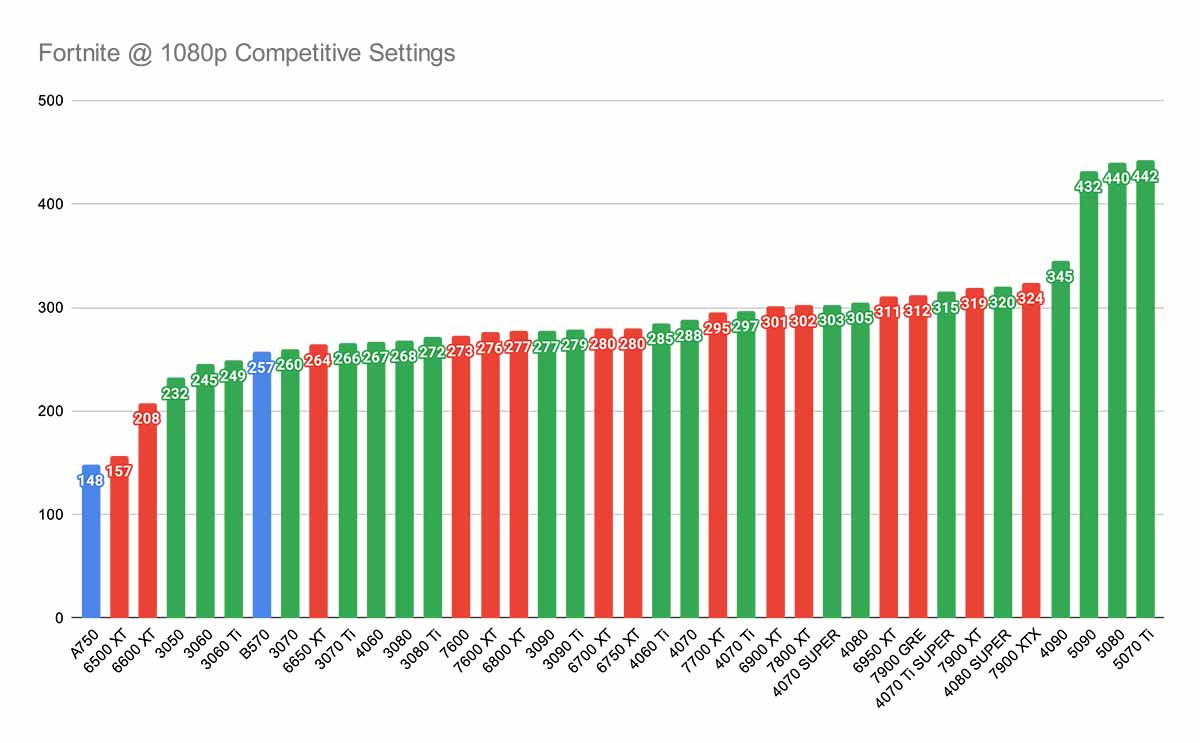
The RX 7900 XT offers a strong 391FPS, and the rest of the cards beyond this point hit ridiculous framerates. Ultimately, this 1080p benchmark isn’t designed to show you that a 5090 can handle Fortnite at 1080p, but it gives you an idea of the generational performance uplifts and the kind of framerates that can be achieved with each card.
Frequently Asked Questions
Do You Need A 12VHPWR Cable?
AMD graphics cards do not require a 12VHPWR cable, while NVIDIA’s RTX 4000 series do. If you do not have one, you can use an adapter included in the box.
Is NVIDIA or AMD Better for Ray Tracing?
While AMD’s graphics cards have come a long way, NVIDIA is generally much better regarding ray traced performance.
Should I Worry About Case Clearance?
You should always check the length of your graphics card versus the maximum clearance in your case to ensure you don’t face any installation problems.


